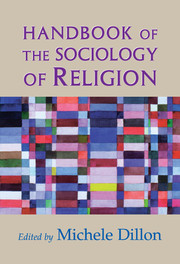Book contents
- Frontmatter
- Contents
- List of Contributors
- Acknowledgment
- Part One Religion as a Field of Sociological Knowledge
- 1 The Sociology of Religion in Late Modernity
- 2 Studying Religion, Making it Sociological
- 3 The Ritual Roots of Society and Culture
- 4 Social Forms of Religion and Religions in Contemporary Global Society
- 5 The Evolution of the Sociology of Religion
- Part Two Religion and Social Change
- Part Three Religion and the Life Course
- Part Four Religion and Social Identity
- Part Five Religion, Political Behavior, and Public Culture
- Part Six Religion and Socioeconomic Inequality
- References
- Index
3 - The Ritual Roots of Society and Culture
Published online by Cambridge University Press: 05 June 2012
- Frontmatter
- Contents
- List of Contributors
- Acknowledgment
- Part One Religion as a Field of Sociological Knowledge
- 1 The Sociology of Religion in Late Modernity
- 2 Studying Religion, Making it Sociological
- 3 The Ritual Roots of Society and Culture
- 4 Social Forms of Religion and Religions in Contemporary Global Society
- 5 The Evolution of the Sociology of Religion
- Part Two Religion and Social Change
- Part Three Religion and the Life Course
- Part Four Religion and Social Identity
- Part Five Religion, Political Behavior, and Public Culture
- Part Six Religion and Socioeconomic Inequality
- References
- Index
Summary
There is probably no better place to begin a discussion of the place of ritual in the sociology of religion than with a famous passage in Emile Durkheim's The Elementary Forms of Religious Life:
Life in Australian [Aboriginal] societies alternates between two different phases. In one phase, the population is scattered in small groups that attend to their occupations independently. Each family lives by itself, hunting, fishing–in short, striving by all possible means to get the food it requires. In the other phase, by contrast, the population comes together, concentrating itself at specified places for a period that varies from several days to several months. This concentration takes place when a clan or a portion of the tribe … conducts a religious ceremony.
These two phases stand in the sharpest possible contrast. The first phase, in which economic activity predominates, is generally of rather low intensity. Gathering seeds or plants necessary for food, hunting, and fishing are not occupations that can stir truly strong passions. The dispersed state in which the society finds itself makes life monotonous, slack, and humdrum. Everything changes when a [ceremony] takes place. … Once the individuals are gathered together a sort of electricity is generated from their closeness and quickly launches them into an extraordinary height of exaltation. … Probably because a collective emotion cannot be expressed collectively without some order that permits harmony and unison of movement, [their] gestures and cries tend to fall into rhythm and regularity, and from there into songs and dances
(1912/1976: 214–16).- Type
- Chapter
- Information
- Handbook of the Sociology of Religion , pp. 31 - 44Publisher: Cambridge University PressPrint publication year: 2003
- 10
- Cited by



